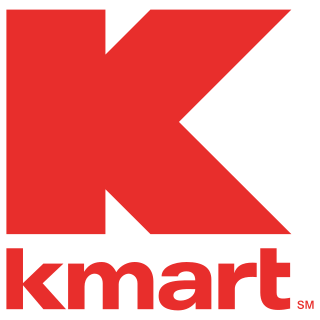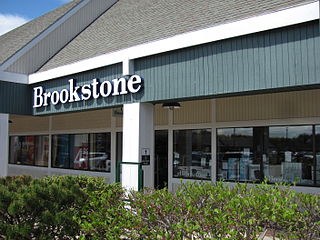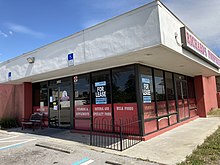
Kmart, formerly legally registered as Kmart Corporation, now operated by Transformco, is an online retailer in the United States and operates six remaining Kmart big-box department stores — 3 in the US Virgin Islands and one each in Kendale Lakes, Florida ; Bridgehampton, Long Island; and Tamuning, Guam.

Sears, Roebuck and Co., commonly known as Sears, is an American chain of department stores founded in 1892 by Richard Warren Sears and Alvah Curtis Roebuck and reincorporated in 1906 by Richard Sears and Julius Rosenwald, with what began as a mail ordering catalog company migrating to opening retail locations in 1925, the first in Chicago. In 2005, the company was bought by the management of the American big box discount chain Kmart, which upon completion of the merger, formed Sears Holdings. Through the 1980s, Sears was the largest retailer in the United States. In 2018, it was the 31st-largest. After several years of declining sales, Sears's parent company filed for Chapter 11 bankruptcy on October 15, 2018. It announced on January 16, 2019, that it had won its bankruptcy auction, and that a reduced number of 425 stores would remain open, including 223 Sears stores.

Toys "R" Us is an American toy, clothing, and baby product retailer owned by Tru Kids and various others. The company was founded in 1948; its first store was built in April 1948, with its headquarters located in Parsippany-Troy Hills, New Jersey, in the New York metropolitan area.
A discount store or discounter offers a retail format in which products are sold at prices that are in principle lower than an actual or supposed "full retail price". Discounters rely on bulk purchasing and efficient distribution to keep down costs.

Eaton Centre is a name associated with shopping centres in Canada, originating with Eaton's, one of Canada's largest department store chains at the time that these malls were developed. Eaton's partnered with development companies throughout the 1970s and 1980s to develop downtown shopping malls in cities across Canada. Each mall contained an Eaton's store, or was in close proximity to an Eaton's store, and typically the mall itself carried the "Eaton Centre" name. These joint ventures were a significant retail development trend in Canada during that period.

Brookstone is a chain of retail stores in the United States and China. It was founded as a mail-order business in 1965, when it started selling items, such as dental clamps and other specialty tools. Its first physical location opened in 1973 in Peterborough, New Hampshire. The company's headquarters are currently located in Merrimack, New Hampshire.
The Village at Orange, formerly known as the Orange Mall and later as The Mall of Orange, was a minor enclosed shopping mall located in Orange, California. The mall, one of Orange's first, opened for consumer entry in 1971, and was composed of both internal merchants and external anchor tenant buildings, the original latter of which only Walmart remains operational. In September 2023, TVO Management, the mall's property manager, announced that the internal portion of the mall would close on or by January 31, 2024. The mall ceased internal operations on the date provided by TVO Management, marking the end of 52 years of constant public operation in Northern Orange.

Stones River Town Centre is a partially enclosed regional shopping mall in Murfreesboro, Tennessee, United States. Built in 1992, it was expanded and renovated in the late 2000s. The mall comprises more than fifty stores. The mall is owned and managed by Sterling Organization. The anchor stores are Shoe Carnival, Books-A-Million, Electronic Express, AMC Theatres, Strike & Spare, JCPenney, and Dillard's.

Swansea Mall was a regional shopping mall located in Swansea, Massachusetts. It served the Southeastern Massachusetts area. Located off Exit 3 of I-195, the building is situated at the intersection of U.S. Route 6 and Massachusetts Route 118, on Swansea Mall Drive. It had three out-parcel buildings: a Walmart building behind the mall, a former Toys "R" Us, a shared PriceRite & Dollar Tree. The Swansea Crossings shopping plaza is across the street, and contains a Big Lots and a Tractor Supply Company. The mall closed permanently on March 31, 2019. It was purchased by Anagnost Companies in May 2019 at auction.

College Square is an indoor regional shopping mall located in Morristown, Tennessee. College Square is owned by Time Equities Inc and managed by Urban Retail Properties. It features approximately 50 stores and restaurants including AMC College Square 12.

Rego Center is a shopping mall bordered by the Long Island Expressway, Junction Boulevard, Queens Boulevard, 63rd Drive, and 99th Street in the Rego Park neighborhood of Queens in New York City.

The Harford Mall is a shopping mall owned by CBL & Associates Properties that is located near the junction of Maryland Route 24 and U.S. Route 1, about 32 miles (51 km) north of Baltimore, in Bel Air, Maryland, United States. Its anchor is Macy's. It is the only shopping mall in Harford County, Maryland. The mall was built on the previous site of the Bel Air Racetrack.
The Summit, formerly Summit Park Mall, was an enclosed shopping mall in Wheatfield, New York. Opened in 1972, the mall became largely vacant by the late 1990s. It underwent renovations in 2004 and 2005 which added new anchor stores and tenants, but after the mall's developers filed for bankruptcy protection in 2009, the complex was closed except for three anchor stores: Sears, The Bon-Ton and Save-A-Lot, with two more vacant anchors last occupied by Steve & Barry's and a Macy's closeout store. As of September 2017, Save-A-Lot has closed permanently, leaving only Sears and The Bon-Ton still open in the mall. On April 18, 2018, it was announced that The Bon-Ton would be closing in August 2018. as it is going out of business leaving Sears as the only tenant left. On May 7, 2018, Sears announced that would also be closing in August 2018. In December 2019, within Sears' old location, The Niagara International Sports & Entertainment facility opened. In 2020, a plan was proposed to revitalize the location, converting part of the mall into mixed use spaces, as well as offering lodging for visitors. Developers plan to expand the project to eventually include ice rinks, shops, and eateries.
Sears Holdings Corporation was an American holding company headquartered in Hoffman Estates, Illinois. It was the parent company of the chain stores Kmart and Sears and was founded after the former purchased the latter in 2005. It was the 20th-largest retailing company in the United States in 2015. It filed for Chapter 11 bankruptcy on October 15, 2018, and sold its assets to ESL Investments in 2019. The new owner moved Sears assets to its newly formed subsidiary Transform Holdco LLC and after that, Sears Holdings Corporation was closed.

Target Canada Co. was the Canadian subsidiary of the Target Corporation, the eighth-largest retailer in the United States. Formerly headquartered in Mississauga, Ontario, the subsidiary formed with the acquisition of Zellers store leases from the Hudson's Bay Company (HBC) in January 2011. Target Canada opened its first store in March 2013, and by January 2015 was operating 133 locations throughout Canada. Its main competition included Walmart Canada, Loblaws, Shoppers Drug Mart, and Canadian Tire.
Florin Towne Centre is an outdoor shopping center in the unincorporated area of Parkway-South Sacramento in Sacramento County, California, United States, in the Sacramento area. It opened in 2008 on the site of the old Florin Mall, which closed and was demolished in 2006. The 484,500 square feet (45,010 m2) center is anchored by AutoZone, Chuze Fitness, PetSmart, US Foods CHEF'STORE, and Walmart Supercenter.

Lincoln Park Shopping Center was a shopping center located at the corner of Southfield Road and Dix Highway, mostly in Lincoln Park, Michigan, though a portion containing a former Farmer Jack supermarket and a former Wendy's restaurant lay in neighboring Allen Park. Anchored by Sears and completed by 1957, it was one of the first large-scale strip complexes in the Downriver Detroit suburbs prior to the 1970 opening of Southland Center.
Transform SR Brands LLC is an American privately held company formed on February 11, 2019, to acquire some of the assets of Sears Holdings Corporation. The new company is owned by ESL Investments. Following the Chapter 11 bankruptcy filing of Sears Holdings on October 15, 2018, Transformco purchased the surviving assets owned by Sears Holdings for $5.2 billion.

The COVID-19 pandemic has taken a sharp economic toll on the retail industry worldwide as many retailers and shopping centers were forced to shut down for months due to mandated stay-at-home orders. As a result of these closures, online retailers received a major boost in sales as customers looked for alternative ways to shop and the effects of the retail apocalypse were exacerbated. A number of notable retailers filed for bankruptcy including Ascena Retail Group, Debenhams, Arcadia Group, Brooks Brothers, GNC, J. C. Penney, Lord & Taylor and Neiman Marcus.














